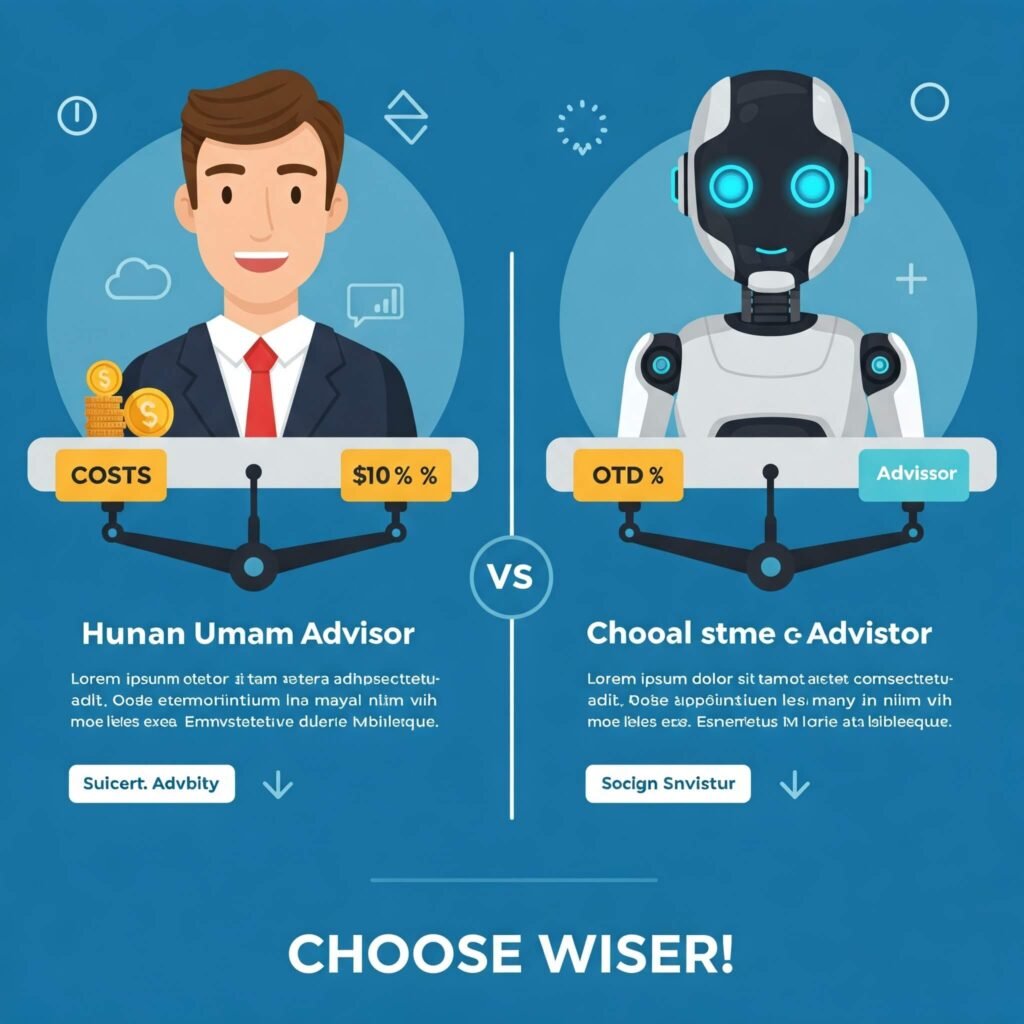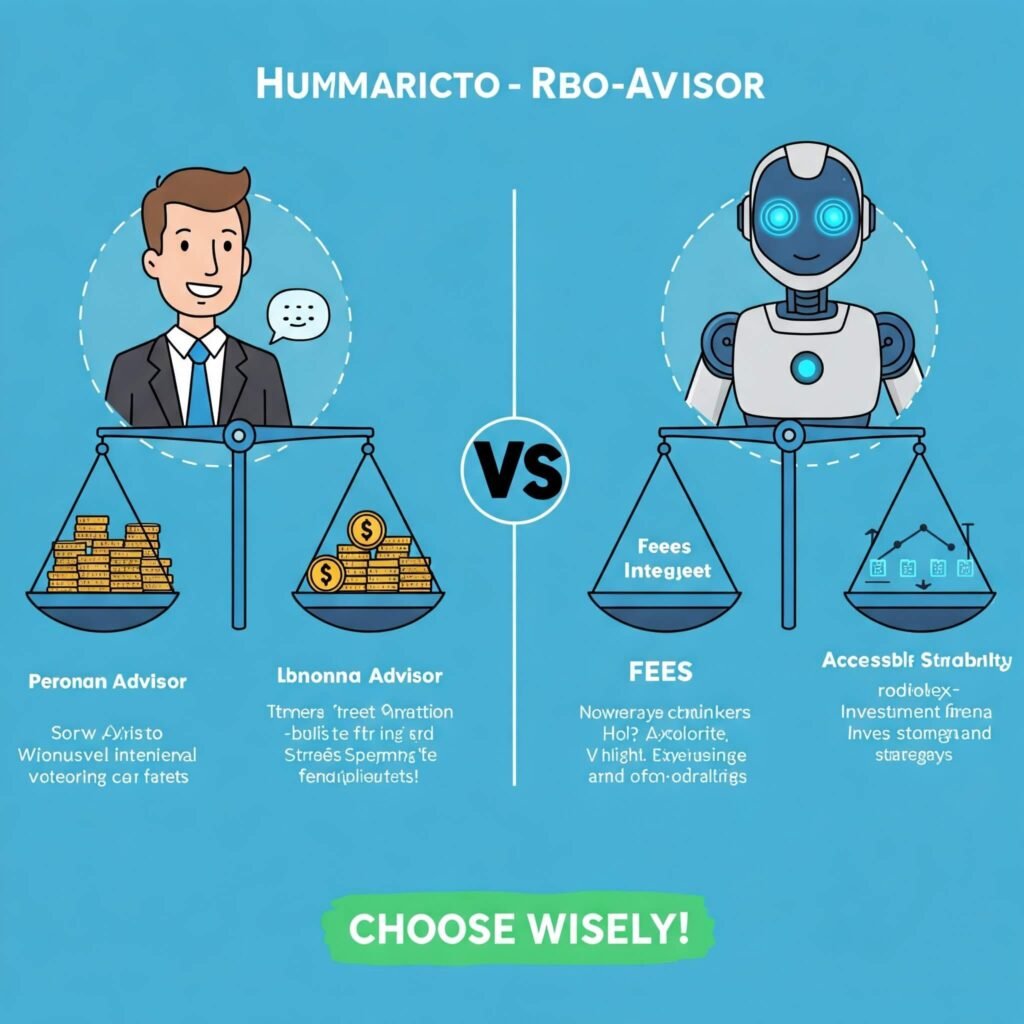Why the Financial Advisor vs. Robo-Advisor Debate Matters
The financial advisor vs. robo-advisor choice impacts how you manage wealth, plan for retirement, or save for big goals. A 2023 Vanguard study found that human advisors can boost returns by up to 3% through tailored strategies, while robo-advisors appeal with low fees (0.25% vs. 1% for advisors). Understanding their differences ensures you pick the best fit for your 2025 financial needs.

What Is a Financial Advisor?
A financial advisor is a professional offering personalized financial guidance, often with credentials like Certified Financial Planner (CFP).
Services in the Financial Advisor vs. Robo-Advisor Comparison
- Comprehensive Planning: Budgeting, retirement, tax, and estate planning.
- Investment Management: Tailored portfolios based on your risk tolerance.
- Personal Support: One-on-one advice for complex situations, like inheritance or divorce.
Example: Sarah, 40, worked with a CFP via SmartAsset to plan her retirement, saving $10,000 in taxes through strategic IRA contributions.
Cost: Typically 1-2% of assets managed or flat fees ($1,000-$5,000 for plans).
What Is a Robo-Advisor?
A robo-advisor is an automated platform using algorithms to manage investments, ideal for hands-off investors.
Features in the Financial Advisor vs. Robo-Advisor Debate
- Automated Portfolios: Builds diversified portfolios based on your risk profile.
- Low Fees: Often 0.25-0.5% of assets, with no minimums on platforms like Betterment.
- Basic Planning: Some offer goal tracking or tax-loss harvesting.
Example: Jake, 28, used Wealthfront to invest $5,000, growing it to $5,800 in a year with minimal effort.
Cost: $0-$50/year for basic accounts; premium plans $100-$500/year.

Financial Advisor vs. Robo-Advisor: Key Differences
To choose between a financial advisor vs. robo-advisor, compare these factors:
- Personalization: Advisors offer tailored advice; robo-advisors use standardized algorithms.
- Cost: Advisors charge 1-2% or flat fees; robo-advisors average 0.25%.
- Complexity: Advisors handle nuanced needs (e.g., business ownership); robo-advisors suit simple investing.
- Accessibility: Robo-advisors are 24/7 via apps; advisors require meetings.
- Human Touch: Advisors provide emotional support; robo-advisors are impersonal.
Data Insight: A 2024 Morningstar study showed robo-advisor users saved 0.75% annually in fees, but 65% missed personalized advice.
Pros and Cons of a Financial Advisor
Pros of Financial Advisors in the Debate
- Customized strategies for complex finances.
- Emotional guidance during market volatility.
- Holistic planning beyond investments.
Cons of Financial Advisors
- Higher fees (1-2% of assets).
- Minimum investment requirements (e.g., $50,000).
- Potential conflicts if commission-based.
Example: Maria, a business owner, chose a fiduciary advisor via CFP Board for tax planning, saving $15,000 annually.
Pros and Cons of a Robo-Advisor
Pros of Robo-Advisors in the Comparison
- Low fees, ideal for small portfolios.
- Easy setup with no financial knowledge needed.
- Automated rebalancing and tax strategies.
Cons of Robo-Advisors
- Limited personalization for unique needs.
- No human support during market downturns.
- Basic planning tools compared to advisors.
Example: Alex, a beginner investor, used Wealthfront to start with $1,000, appreciating the low 0.25% fee.

Who Should Choose a Financial Advisor?
A financial advisor is best if you:
- Have complex finances (e.g., business, inheritance, divorce).
- Want holistic planning (retirement, taxes, estate).
- Value personal guidance during financial decisions.
- Can afford higher fees or meet asset minimums.
Pro Tip: Look for fiduciary advisors who prioritize your interests, verified via NAPFA.
Who Should Choose a Robo-Advisor?
A robo-advisor suits you if you:
- Are starting with a small portfolio ($0-$10,000).
- Prefer low-cost, hands-off investing.
- Have simple financial goals (e.g., saving for a car).
- Are comfortable with digital-only platforms.
Pro Tip: Try hybrid platforms like Vanguard Personal Advisor for a mix of robo and human advice.
Can You Use Both in the Financial Advisor vs. Robo-Advisor Mix?
Yes! Combining both can balance cost and personalization. For example, use a robo-advisor for basic investing and a financial advisor for complex planning. A 2024 Schwab survey found 30% of investors use both, saving on fees while getting tailored advice.
Example: Lisa used Betterment for her $10,000 portfolio and a CFP for retirement planning, optimizing costs and strategy.
How to Decide: Financial Advisor vs. Robo-Advisor
Follow these steps to choose:
- Assess Your Needs: Need comprehensive planning or simple investing?
- Evaluate Budget: Can you afford 1-2% fees, or prefer 0.25%?
- Check Comfort Level: Want human advice or trust algorithms?
- Test Options: Start with a robo-advisor’s free account or a one-time advisor consultation.
- Review Credentials: Ensure advisors are CFPs; verify robo-advisors use SEC-registered platforms.
Pro Tip: Use tools like SmartAsset to match with advisors or compare robo-advisors.
Final Thoughts on Financial Advisor vs. Robo-Advisor
The financial advisor vs. robo-advisor decision boils down to your goals, budget, and preference for personalization. Financial advisors excel for complex needs and human guidance, while robo-advisors offer low-cost, automated investing. In 2025, you can even blend both for the best of both worlds. Take the first step today—explore a robo-advisor or schedule an advisor consultation to build your financial future.











































